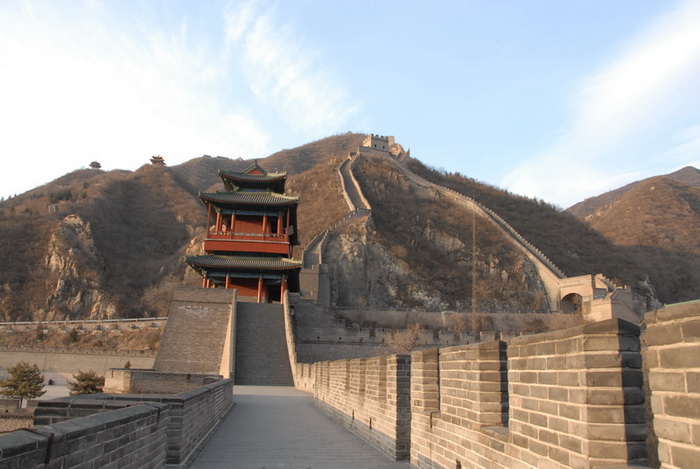http://www.bjlyw.com/bj/jingdianhuizong/beijing/juyongguanchangcheng/

Juyongguan. As a most famous pass of the Great Wall, Juyongguan was the head of the three inner passes, and a barrier to the northwest of Beijing from ancient times. It is seated in the 60 kilometer pass trench along high mountains, to the north of the center of Beijing. High mountains along the pass city are all precipitous cliffs. The pass city is grandly seated among mountains and clutches the passage to Beijing. The full length of the Juyonggang Great Wall is 4142 meters, forming a circle around the pass city. The western part was built on the Jingui Mountain of 2100 meters long. The eastern part was built on the Cuiping Mountain of 1500 meters long. The Southern Pass Watercourse Great Wall is 324 meters long, there were built two water gates. The Northern Pass Watercourse Great Wall is 218 meters long. Owning to the most precipitous topography, Juyongguan had its great strategic importance. In the early days of the Ming Dynasty, for avoiding the Yuan Regime’s comeback, Emperor Zhu Yuanzhang ordered Xu Da to rebuild Juyongguan. The initial construction in the Ming Dynasty was in the Hong Wu Period. From then on, constructions hardly paused during the whole dynasty, among which a most massive one took place in the first year of the Jing Tai Period.
The prominent topography of Juyongguan resulted in constant warfare there. In 1122 the Jin troops broke through the pass and kept going southward, and finally took Liao’s capital Yanjing (today’s Beijing) and overthrew the kingdom. At the end of the Jin Dynasty, the Mongolian troops occupied the pass for many times. In 1209 the first emperor of the Yuan Dynasty personally commanded his troops to attack Juyongguan, but could not conquer for a long time because of the Jin troops’ resistance. Then the Mongols began to attack Zijingguan, and simultaneously went round Zhuozhou and Yizhou two prefectures to the inner side of the pass. Finally under the pincer attack, Juyongguan was conquered. When the Ming troops overthrew the Yuan Regime, Juyongguan was also the crucial gap. After the pass had been taken, the Ming troops drove straightly into the pass city and easily took the Capital Beijing. 277 years later, the peasant troop of insurgence lead by Li Zicheng attacked and seized the pass, went into Beijing and finally overthrew the Ming Dynasty.
Although warfare beaten, Juyongguan has witnessed more peaceful life. In the ancient tomb of the Eastern Han Dynasty excavated in Helinger of Inner Mongolia, a fresco vividly describes Juyongguan’s busy communications and prosperity at the time. In the center of the pass city there is a white marble platform constructed in 1345, called ‘the Cloud Platform’, on which the Over-Street Tower and the Peace Temple were built successively, but today only the platform is left. The arched door of the platform and inner wall of the wall were minutely carved out. The carvings include various gods and symbolistic animals, dragons, clouds, etc. in Lamaism. The most striking ones are the relief of the Four Chief Gods and the intaglio inscription of The Dharani Incantation, etc. on both sides of the inner wall. As early as the Jin Dynasty 800 years ago, Juyongguan was listed in the Eight Most Famous Scene in Yanjing, called ‘the Steep and Verdant Juyong’.